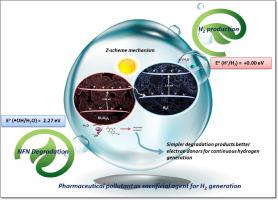Journal of Molecular Liquids ( IF 5.3 ) Pub Date : 2021-09-23 , DOI: 10.1016/j.molliq.2021.117652 Anamika Rana 1 , Amit Kumar 2, 3, 4 , Gaurav Sharma 2, 3 , Mu. Naushad 5 , Chinna Bathula 6 , Florian J. Stadler 2

|
The dual-function photocatalytic systems with a promising capability for hydrogen evolution and simultaneous pollutant degradation are surely a significant step towards waste-to-energy conversion goals. However, the performance of such photocatalysts is often limited by poor visible-light activity, charge separation and surface reverse reaction involving photogenerated electrons and radicals/intermediates. In this work, we report hydrothermal synthesis of novel Bi7O9I3/B4C (BIBC) heterojunction photocatalyst for advanced Norfloxacin antibiotic degradation with simultaneous hydrogen evolution under visible light. In particular, BIBC-30 heterojunction shows H2 evolution rate of 812 μmol g−1h−1 with simultaneous 94.2% NFN removal which are much higher than bare B4C (∼6 times) and Bi7O9I3 (∼4 times). Under oxic/aerobic conditions too, a high 456.3 μmol g−1h−1H2 evolution with nearly complete norfloxacin degradation was achieved. The low band gap of Bi7O9I3 and presence of metallic Bio extends the absorbance to NIR region and B4C enlarges the surface area of junction along with suppression of the back reaction. It was observed that BIBC heterojunction exhibits manifolds H2 evolution rate with NFN as sacrificial agent (18.3% apparent quantum efficiency) is manifolds higher than pure water, methanol, triethanolamine and rhodamine B. An effective Z-scheme charge transfer facilitated by Bio is active in the intimately coupled heterojunction with suitably placed energy bands. This work shows that waste to energy conversion can be promisingly achieved by performing H2 evolution and pollutant removal simultaneously.
中文翻译:

药物污染物作为牺牲剂,通过新型 Z 型 Bi7O9I3/B4C 异质结光催化剂实现可持续协同水处理和制氢
双功能光催化系统具有良好的析氢和同时降解污染物的能力,无疑是朝着废物能源转化目标迈出的重要一步。然而,这种光催化剂的性能通常受到较差的可见光活性、电荷分离和涉及光生电子和自由基/中间体的表面逆反应的限制。在这项工作中,我们报告了新型 Bi 7 O 9 I 3 /B 4 C (BIBC) 异质结光催化剂的水热合成,用于高级诺氟沙星抗生素降解,同时在可见光下析氢。特别是,BIBC-30 异质结显示出812 μmol g -1 的H 2析出率h -1同时具有 94.2% NFN 去除率,远高于裸 B 4 C(~6 倍)和 Bi 7 O 9 I 3(~4 倍)。在好氧/好氧条件下,也实现了高达 456.3 μmol g -1 h -1 H 2 的释放,并且几乎完全降解诺氟沙星。Bi 7 O 9 I 3的低带隙和金属Bi o 的存在将吸收扩展到NIR 区域,B 4 C 扩大了结的表面积,同时抑制了逆反应。观察到 BIBC 异质结表现出流形 H 2以 NFN 作为牺牲剂的进化速率(18.3% 表观量子效率)比纯水、甲醇、三乙醇胺和罗丹明 B 高出许多倍。由 Bi o促进的有效 Z 型电荷转移在具有适当放置能量的紧密耦合异质结中是活跃的乐队。这项工作表明,通过同时进行 H 2析出和污染物去除,可以很有希望地实现废物到能源的转换。











































 京公网安备 11010802027423号
京公网安备 11010802027423号